Bienvenidos queridos lectores y amantes de la buena cocina
Welcome dear readers and lovers of good cooking
I know that the Christmas holidays are over, but since I did not have the opportunity to do so at the time, today I want to share with you the preparation of the central element of the Venezuelan Christmas Dinner, our beloved Hallaca. Its preparation is a Venezuelan tradition, it is synonymous with Christmas parties and not only with family, but also with friends and neighbors. We usually prepare many, of these small gifts wrapped in banana leaves to be able to share with those people who are important in our lives.
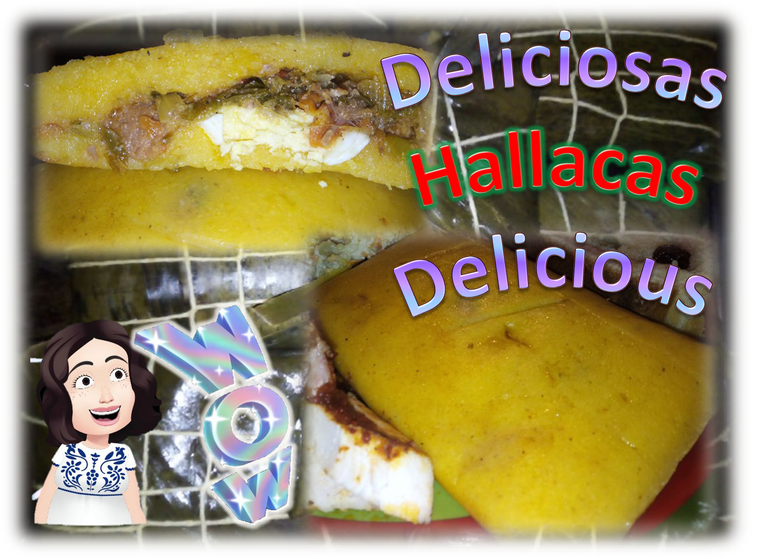

Their preparation is a time for the family to gather and share as they prepare our rich, multi-sapid hallaca. Each member has a role in the preparation, usually the matriarch of the family is in charge of preparing the stew, which is why the phrase "the best hallaca is made by my mother" is coined in the national slang. And this is due to the fact that each family puts its own personal touch on it, and moreover, each region of the country has its own variations in terms of the recipe.

Another essential element is the dough and although it may seem simple, it is not, because you can eliminate the magic of a hallaca, if the dough does not have the perfect flavor, that complements a delicious stew. Then there is the essential work of assembling hallacas, and finally the tying up, a task that is usually done by the youngest member of the family work team, but it is still an important part of the process. It is a whole family experience that is normally seasoned musically with the traditional Christmas bagpipes, but I don't digress any further, we are going to begin the explanation and I will try to make it as simple as possible, hoping that you will dare to prepare our famous Christmas dish.

For this first step, I will start by listing the necessary ingredients to prepare approximately 60 medium hallacas. Of course you can vary the amounts depending on the quantity you want. I must emphasize, that what I will describe from this moment on is our family recipe, of an oriental style hallaca. But as I already mentioned, each family group has its own particular touch.

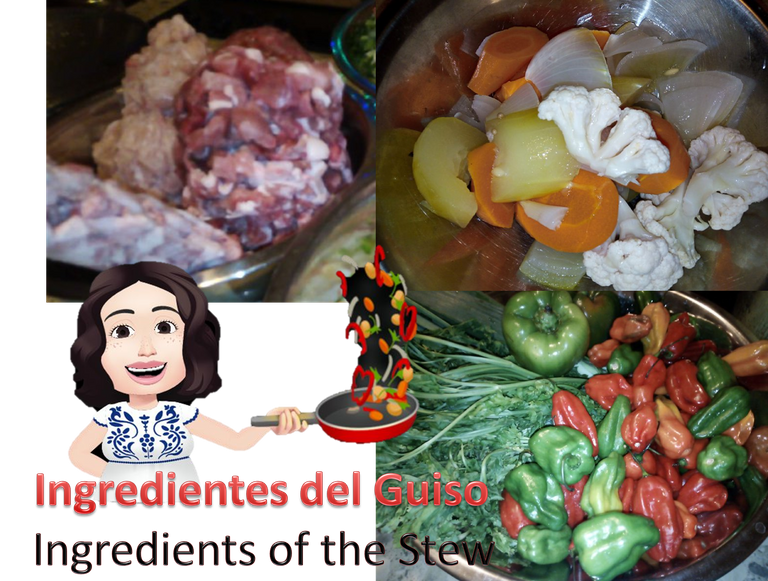

• 3 Kgrs de Carne de Cochino
• 1 Kg de Carne de Res
• 1 Kg. de Pechuga de Pollo
• 2 pimentones
• 4 Cebollas Grandes
• 4 Ajo Porro Grandes
• 4 Apio España Grandes
• 4 Cebollines Grandes
• 3 Manojos de Perejil
• 3 Manojos de Cilantro
• 250 grs de Ají dulce
• 1 cabeza de Ajo
• 1 frasco de 500 grs de vegetales encurtidos (pepinillos, cebolla, zanahoria y coliflor)
• Aceite
• Caldo de pollo
• 1 Cucharada de Onoto
• Sal, Azúcar, Páprika y Pimienta al gusto.
- 3 Kgrs of pork
- 1 Kg of Beef
- 1 Kg. of Chicken Breast
- 2 peppers
- 4 Large Onions
- 4 Large Garlic Reefer
- 4 Celery Spain Large
- 4 Large Chives
- 3 Bundles of Parsley
- 3 Cilantro Bundles
- 250 grs of sweet chili
- 1 head of garlic
- 1 bottle of 500 grams of pickled vegetables (gherkins, onions, carrots and cauliflower)
- Oil
- Chicken broth
- 1 Tbsp Onoto
- Salt, Sugar, Paprika and Pepper to taste



The first thing to do is to chop all the ingredients, the vegetables are chopped in Brunoise, and the meat in small pieces, trying to make them all more or less the same size, so that they are cooked at the same time. Once all this is chopped, we start with the sofrito, for this, we put the pot that we will use in the cooking at medium heat. We add the oil and the “onoto” powder, so that with the heat, the “onoto” releases all its beautiful red color.





Next, we add the garlic, onion and sweet bell pepper, we wait until they start to become transparent, this will be the moment to add the Paprika, Celery Spain, Garlic Porro, Chives, Parsley and Cilantro. We wait until they are fried, to start adding the salt, sugar, paprika, and pepper, according to your taste.



Once the seasonings are fried, it is time to add the different minced meats, we skip them a little. During this process, both the meats and the seasonings release liquid, which we will complete with chicken broth until all the ingredients are covered. Then we cover the pot and let it simmer until the meat softens.



Of course, it should always be stirred so that it does not stick to the bottom of the pot, as well as correcting the taste. A very important detail, is that the stew must be left with enough sauce, it can never be dry, because the liquid will be needed in the next step. Finally, once the stew is ready, we reserve it, waiting for it to reach room temperature.

Para esta etapa de la preparación se deben tener los siguientes ingredientes:
For this stage of the preparation, the following ingredients must be present:
• 3 Kgs. de Harina de Maíz Amarillo.
• Aceite onotado.
• Sal.
• Caldo de pollo.
• Caldo extraído del guiso.
- 3 Kgs. of Yellow Corn Flour.
- Onoted oil.
- Salt.
- Chicken broth.
- Broth extracted from the stew.

In particular, I don't knead all the flour at once, but do it in parts, my recommendation is a maximum of 1 kg of flour at a time. The first thing is to place the corn flour in a tray, where we will knead it, add 3 teaspoons of salt and stir.



From this moment on, we put the liquids in, starting with 3 spoonfuls of oil, and 2 spoonfuls of the stew broth. Then we start kneading and adding the chicken broth, until the flour is completely hydrated.



In my case, I leave it with the texture I would use to prepare an arepa, because in the next stage it will soften a little more. For those who have never prepared an arepa, the texture could be compared to that of "Play Doh" . With the dough ready, the next step is to separate it into small balls, from each kg of flour come out approximately 20 balls of dough.

For this stage we must organize everything to start building them up. I will list the ingredients that we will need
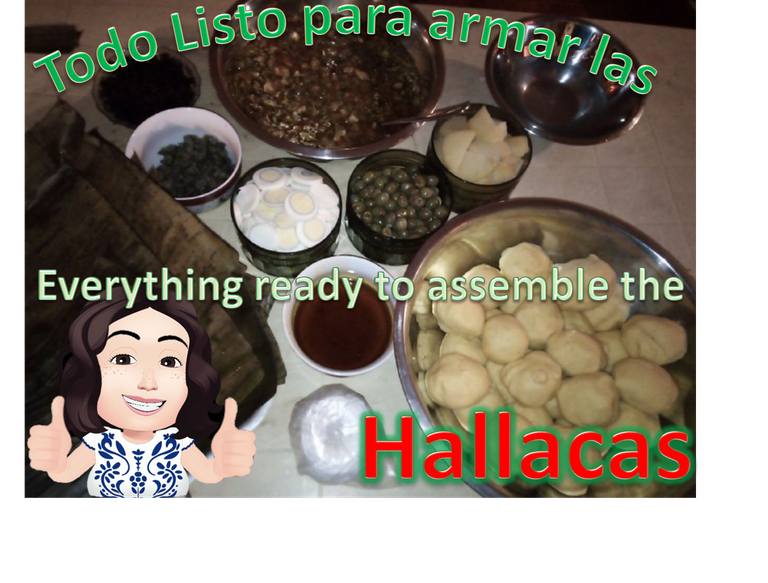
INGREDIENTES || INGREDIENTS
• Hojas de plantas de Plátano o cambur
• Aceite onotado
• Guiso de hallacas (En el paso 1 se explica cómo se prepara)
• Aceitunas deshuesadas
• Alcaparras
• Uvas pasas
• Papas sancochadas picadas en rodajas
• Huevos sancochado picados en rodajas
• Hilo pabilo
• Masa de harina de maíz (En el paso 2 se explica cómo se prepara)
- Banana or cambur plant leaves
- Onoted oil
- Hallaca Stew (Step 1 explains how to prepare it)
- Pitted olives
- Capers
- Raisins
- Sliced boiled potatoes
- Sliced boiled eggs
- Wick thread
- Cornmeal dough (Step 2 explains how to prepare it)

We start this stage, cleaning the leaves of the banana or plantain plants, normally here in Venezuela they sell them prepared, since in order to use them, they must be treated. The process is relatively simple but it is a bit cumbersome, I explain a little, once the leaves are cut from the plant, the central vein is removed and they are like two pieces of cloth. Each piece is divided into squares, if possible 30 X 30 cm. each, but that really depends on the size of the leaf. Then, each piece of leaf we pass it briefly through the flame of the kitchen to that process is called soasara, and allows the leaves to become more flexible and not break when bending or handling.

As I told you, it's a bit cumbersome and well not all of us have banana or cambur plants at our disposal in our garden or yard, so we usually buy them at the supermarket, hahaha. With the leaves clean, we take a piece of it and put it on the counter and smear it with a little bit of oil, then we put a little ball of dough on top and flatten it, until we get a circle as thin as possible. I must emphasize that the notched oil is used to remove the dough from the sheet.

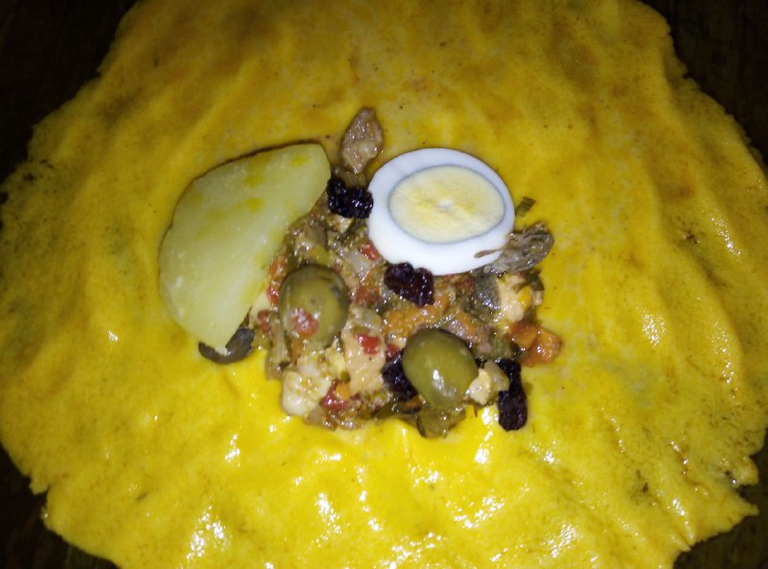

Now, it is time to place the filling, we place it in the center of the dough disk, I place a portion of the stew first. Then we distribute the rest of the ingredients, a slice of potato, one or two slices of egg, 2 or 3 olives, the same amount of capers. Finally, the raisins, as I like many, I put a few, approximately 6 or more.

I must point out again that what I share with you is the way my family prepares it, there are infinite variations in terms of the filling of the hallacas. In some recipes they put little pieces of carrot and paprika, others put chickpeas. Even in some regions of the country they put all the stuffing raw, so everything is cooked at the end, not just the dough. In short, each family or region gives its own identity to this wonderful Christmas dish.

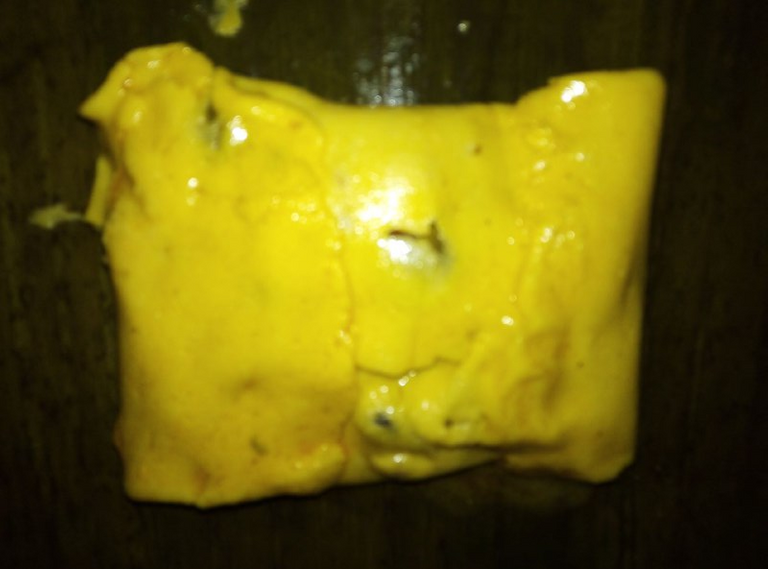

Well, now the hallaca has its filling, it is time to close it, at this point there is also a diversity of techniques, I was taught to fold the ends of the dough, carefully detaching it from the banana leaf, until wrapping the filling and obtaining a rectangle.



Next, it's time to wrap the banana leaf, it's done as if we were wrapping a small gift, always taking care not to break the leaf. And finally the tying with the wick thread is made several turns so that it does not untie what would cause a disaster, hahaha. As you can see, all the steps are important to obtain a good result.

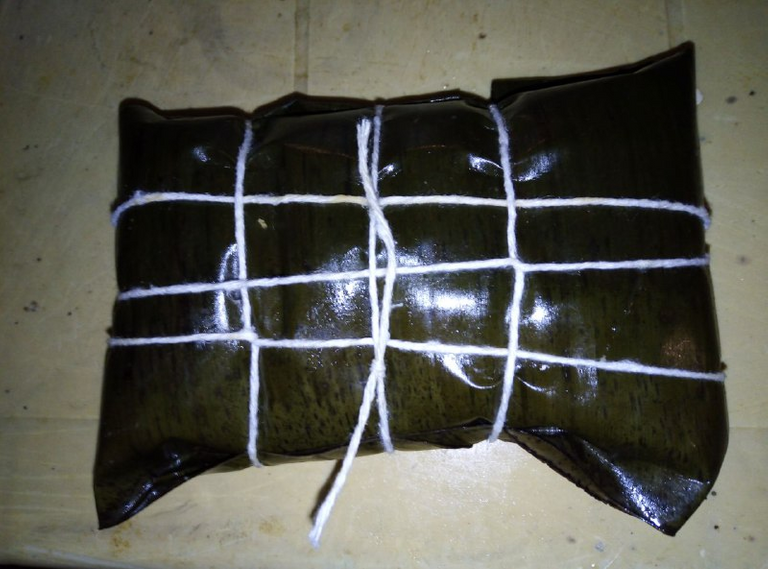

Ok. At this point our first hallaca is ready, only missing the remaining 59, hahaha, to start sancocharlas. No lie, usually when we have a few armed, we put them to cook, to make the first test of all our effort. The cooking time is about 40 minutes and we put them to cook once the water is boiling, this way we avoid water getting inside and damaging them.

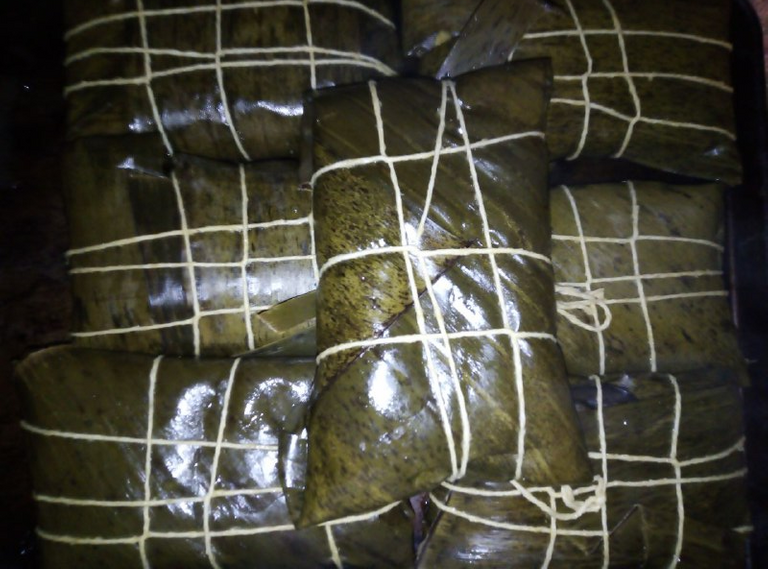

God, I finally finished! I got tired of making this publication and I just kept writing, so imagine how my husband and I looked when we prepared our hallacas. And to think that we prepared half the recipe, some families prepare more than 100 units, it's crazy.


Here I present you The Complete Venezuelan Christmas Dish, Hallaca, Ham Bread, Chicken Salad and Baked Legs

As I mentioned at the beginning, the hallaca is only one of the components of our traditional Christmas dinner. This is also integrated by the Ham Bread, the chicken salad and the roast leg. But I will share these other recipes with you in later deliveries. I hope you liked my recipe, understood it and will dare to prepare it some day.

Contenido y fotografías de mi propiedad intelectual
Información Técnica
| Cámara | Pentax * istDL |
|---|---|
| Lente | * Pentax 18-55 |
| Iluminación | Luz Natural |
| Locación | Barcelona, estado Anzoátegui, Venezuela |
Content and photographs of my intellectual property
Technical information
| Camera | Pentax * istDL |
|---|---|
| Lens | * Pentax 18-55 |
| Lighting | Natural Light |
| Location | Barcelona, state Anzoátegui, Venezuela |


Yum! You have been curated @taco.cat on behalf of FoodiesUnite.net on #Hive. Thanks for using the #foodie tag. We are a tribe for the Foodie community with a unique approach to content and community and we are here on #Hive.
Join the foodie fun! We've given you a FOODIE boost. Come check it out at @foodiesunite for the latest community updates. Spread your gastronomic delights on and claim your tokens.
Join and Post through the Community and you can earn a FOODIE reward.
Congratulations, your post has been upvoted by @dsc-r2cornell, which is the curating account for @R2cornell's Discord Community.
Enhorabuena, su "post" ha sido "up-voted" por @dsc-r2cornell, que es la "cuenta curating" de la Comunidad de la Discordia de @R2cornell.